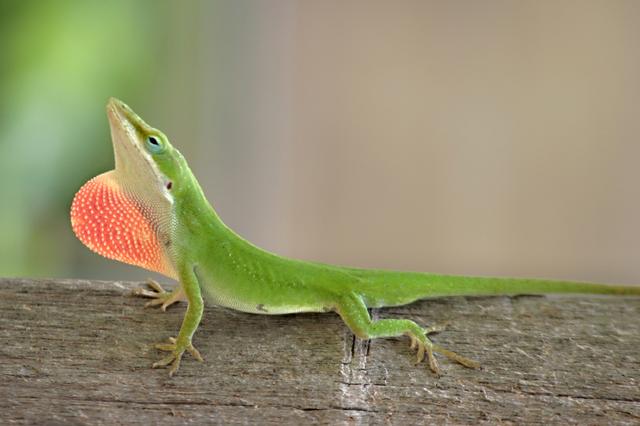Overview
Changing skin color as a method of thermoregulation is a trait found in a number of lizard reptiles. However, for the purpose of this science project, we will be limiting ourselves to one of two species - namely the anole lizard or the green iguana. The anole lizard is recommended over the green iguana as they are inexpensive and only grow to a maximum of six inches, while the green iguana can reach a length of over five feet! Both of these lizards are considered tropical or semi-tropical species, living in environments that have abundant sunlight and high temperatures.
The anole is also known as the "American chameleon," - an inaccurate description in that anoles and chameleons actually belong to different families of lizards. Anoles were dubbed the "American chameleon" because of their ability to change the color of their skin. When the anole wants to raise its body temperature, it can either bask on a branch, or it might change its skin to a dark brown color. Dark colors absorb heat, hence turning brown enables the anole to absorb heat more rapidly. If the anole wants to maintain its current body temperature, or reduce it, it will turn a lighter color, such as light green. Lighter colors reflect heat, though turning green also has the added benefit of helping camouflage the anole among the branches and leaves that it inhabits. Review the resources in the bibliography section for information on how to care for the anole.
Scientific Terms
Materials
- Anole lizard - Anoles can be purchased at pet stores that have a reptile section.
- Terrarium and other equipment need to house and care for the anole See resources in bibliography section for details on how to prepare the terrarium and needed supplies.
- table lamp with incandescent bulb
- Thermometer - Any thermometer will work, including aquarium thermometers. You will need it to monitor changes in temperature.
Procedure
Note: This experiment involves causing the body temperature of the anoles to change. As reptiles require the proper temperature to digest their food, do not conduct this experiment after the anole has eaten. Conduct the experiment either before the anole has eaten or two hours after its meal.
The ideal temperature for anoles is between 75 and 90 degrees fahrenheit. Observe the color of the anole?s skin when the temperature is in this range. Record your observation. You may wish to take a photo of the anole under these temperature conditions.
Lower the temperature to 70 degrees by turning off the table lamp or reducing the wattage of the light bulb. Wait for 30 minutes, what color is the anole?s skin now? Record your observations and take photos if necessary.
References
- "Keeping Green Anoles as Pets," from About.com Exotic Pets http://exoticpets.about.com/cs/lizardsaspets/a/greenanolecare.htm
- "Green Anoles: Perfect Pets" http://www.anoliscarolinensis.com/

